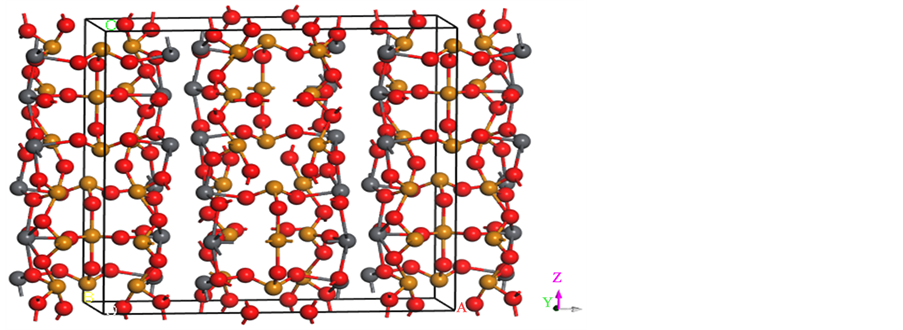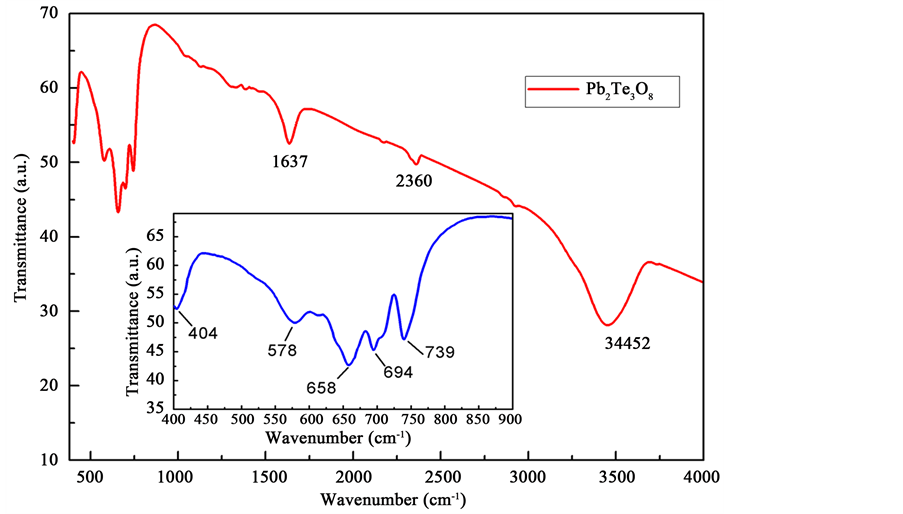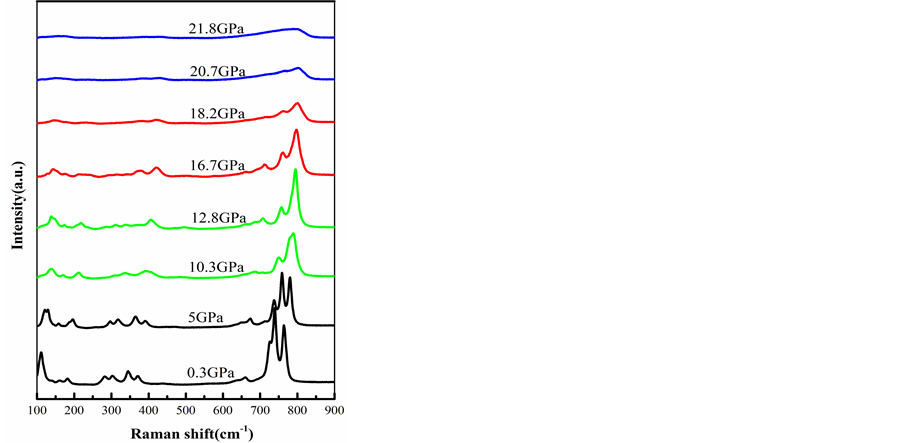Modern Physics
Vol.07 No.03(2017), Article ID:20813,8
pages
10.12677/MP.2017.73007
Physical Properties Studies of Pb2Te3O8 Synthesized by Hydrothermal Method
Yan Ma1, Wendan Wang1,2*, Linji Zhang1,2
1Key Laboratory of Advanced Technologies of Materials, School of Physical Science and Technology, Southwest Jiaotong University, Chengdu Sichuan
2Key Laboratory (for Universities) of High Pressure Science and Technology, Southwest Jiaotong University, Chengdu Sichuan

Received: May 8th, 2017; accepted: May 28th, 2017; published: May 31st, 2017

ABSTRACT
Pb2Te3O8 samples were prepared by hydrothermal synthesis. The phase and structural parameters of the synthesized Pb2Te3O8 sample were determined by Rietveld refinement of the observed powder XRD data. The infrared absorption spectra, ambient pressure and high pressure Raman spectra of Pb2Te3O8 were measured. The infrared absorption peak of Pb2Te3O8 was determined by infrared spectroscopy. The high-pressure Raman study was carried out at room temperature by using a diamond anvil, and the Raman spectra were measured in the range of 0.3 - 21.8 GPa. By analyzing the frequency shift and splitting of the Raman peak, it is found that the frequency of all the vibrational modes varies monotonically and without the presence of new peaks as the pressure increase, this change in the Raman spectrum indicates that the structure of Pb2Te3O8 can be stabilized to 21.8 GPa without phase transition.
Keywords:Pb2Te3O8, Hydrothermal Synthesis, Infrared Absorption Spectrum, High Pressure Raman Spectra
水热法合成Pb2Te3O8及其物性研究
马艳1,王文丹2*,张林基1,2
1西南交通大学物理科学技术学院,材料先进技术教育部重点实验室,四川 成都
2西南交通大学,高压科学与技术重点实验室,四川 成都

收稿日期:2017年5月8日;录用日期:2017年5月28日;发布日期:2017年5月31日

摘 要
利用水热合成法制备了Pb2Te3O8单晶样品,通过晶体结构精修软件GSAS对X射线衍射图谱的精修确定了样品相及其结构参数。随后对Pb2Te3O8进行了红外吸收光谱以及高压拉曼光谱测试。红外光谱实验中确定了Pb2Te3O8对应的红外吸收峰位置,高压拉曼研究是利用金刚石压砧在室温下进行,在0.3~21.8 GPa压强范围内测定了拉曼光谱,通过分析拉曼峰的频移和劈裂变化情况,发现随着压力的增加所有振动模的频率是单调线性变化的并且没有新峰出现,拉曼谱图的这种变化表明在Pb2Te3O8在压力高达21.8 GPa高压拉曼实验中并没有压力引起的相变发生。
关键词 :Pb2Te3O8,水热法,红外吸收光谱,高压拉曼光谱

Copyright © 2017 by authors and Hans Publishers Inc.
This work is licensed under the Creative Commons Attribution International License (CC BY).
http://creativecommons.org/licenses/by/4.0/


1. 引言
金属亚碲酸盐中由于Te (IV)有一对立体活性的孤对电子,使得其在磁性、荧光以及非线性光学材料等方面具有广泛的应用,并且吸引了大量学者对其开展研究 [1] - [7] 。Te4+中4 s孤对电子使得Te (IV)具有非对称的配位环境,这使得金属亚碲酸盐可以表现出丰富的结构化学,而且很容易形成非中心对称的极性结构,这种极性结构可以决定其具有一些非常优异的物理性能,比如非线性光学二次谐波(SHG)、压电性、铁电性等 [8] [9] 。目前为止,有大量的金属碲(IV)氧化物曾被报道。在这些金属亚碲酸盐中通常包括 ,
,  ,
, 这几个结构单元,
这几个结构单元, 曾经在一些化合物比如CuTe2O5 [10] , CuTeO3 [11] , NiTe2O5 [12] , Nb2Te4O13 [13] , Ga2Te4O11 [14] 中被观察到,
曾经在一些化合物比如CuTe2O5 [10] , CuTeO3 [11] , NiTe2O5 [12] , Nb2Te4O13 [13] , Ga2Te4O11 [14] 中被观察到, 单元曾在CuTe2O5 [10] , Te6O11Cl2 [15] , V2MnTeO7 [16] 以及BaMTeO4(PO4) (M = Nb, Ta) [17] 中观察到,最后的
单元曾在CuTe2O5 [10] , Te6O11Cl2 [15] , V2MnTeO7 [16] 以及BaMTeO4(PO4) (M = Nb, Ta) [17] 中观察到,最后的 在亚碲酸盐中是很重要的结构单元,被报道存在于Zn2Te3O8 [18] , Ni2Te3O8 [19] , Mn2Te3O8 [20] 和Cu2Te3O8 [21] 这些金属碲氧化物中,然而这些亚碲酸盐都只是涉及到过渡金属,并没有主族金属。在主族金属中,Pb元素具有其独特的电子结构而吸引了很多学者的兴趣,曾有文章报道当引入Pb原子时其中Pb2+中6s2孤对电子的存在可以破坏一些物质的中心对称结构 [22] - [30] ,产生新的结构以及性质,因此在金属亚碲酸盐中同时引入Pb、Te元素对其结构及性质也将会有很大的影响,因此在我们这篇文章中我们将通过水热合成法合成出主族金属亚碲酸盐Pb2Te3O8,在所有这些碲酸盐中Pb2Te3O8的相关研究几乎没有,仅有的研究报道主要是关于它的结构研究,其分子结构模型如图1所示 [6] 。Pb2Te3O8单晶样品是通过在纯氮气流下在970 K温度的金坩埚中加热Pb2Te3O8结晶化合物12小时的方法得到,然后以1 K/h冷却速度将其冷却至293 K,通过此实验研究获得了Pb2Te3O8的晶体结构以及空间群信息。关于Pb2Te3O8的热力学性质的研究是由G. Gospodinov和L. Anastasia进行的 [1] 。通常高压下的多晶化合物比其常压下的化合物物更致密,并且通常具有分层或紧密堆积的结构,因此在新材料领域,高压相变结构的应用是非常有前景的。在本文中,我们通过水热法合成Pb2Te3O8并且对其晶体结构进行了分析,并且在金刚石压砧(DAC)中获得了高压原位拉曼光谱,与此同时还进行了红外吸收光谱研究。
在亚碲酸盐中是很重要的结构单元,被报道存在于Zn2Te3O8 [18] , Ni2Te3O8 [19] , Mn2Te3O8 [20] 和Cu2Te3O8 [21] 这些金属碲氧化物中,然而这些亚碲酸盐都只是涉及到过渡金属,并没有主族金属。在主族金属中,Pb元素具有其独特的电子结构而吸引了很多学者的兴趣,曾有文章报道当引入Pb原子时其中Pb2+中6s2孤对电子的存在可以破坏一些物质的中心对称结构 [22] - [30] ,产生新的结构以及性质,因此在金属亚碲酸盐中同时引入Pb、Te元素对其结构及性质也将会有很大的影响,因此在我们这篇文章中我们将通过水热合成法合成出主族金属亚碲酸盐Pb2Te3O8,在所有这些碲酸盐中Pb2Te3O8的相关研究几乎没有,仅有的研究报道主要是关于它的结构研究,其分子结构模型如图1所示 [6] 。Pb2Te3O8单晶样品是通过在纯氮气流下在970 K温度的金坩埚中加热Pb2Te3O8结晶化合物12小时的方法得到,然后以1 K/h冷却速度将其冷却至293 K,通过此实验研究获得了Pb2Te3O8的晶体结构以及空间群信息。关于Pb2Te3O8的热力学性质的研究是由G. Gospodinov和L. Anastasia进行的 [1] 。通常高压下的多晶化合物比其常压下的化合物物更致密,并且通常具有分层或紧密堆积的结构,因此在新材料领域,高压相变结构的应用是非常有前景的。在本文中,我们通过水热法合成Pb2Te3O8并且对其晶体结构进行了分析,并且在金刚石压砧(DAC)中获得了高压原位拉曼光谱,与此同时还进行了红外吸收光谱研究。

Figure 1. Molecular structure model of Pb2Te3O8
图1. Pb2Te3O8的分子结构模型
2. 实验
使用购买的Na2TeO3 (99.9%,科龙化工)和Pb(NO3)2 (99.9%,科龙化工)作为原料。将Pb(NO3)2 (0.222 g,0.6702 mmol)溶解在2 mL H2O中,然后将该溶液加入到8 mL的Na2TeO3 (0.223 g,1.006 mmol)水溶液中,混合后出现大量白色沉淀。将该混合物置于13 mL的石英内衬的高压釜中,加热至230℃并保温24小时,然后让高压釜自然冷却4小时,取出含有样品的混合液体,过滤收集产物,用蒸馏水反复洗涤,并在空气中干燥,最终就可以得到Pb2Te3O8晶体,通过水热法制备Pb2Te3O8晶体的过程中最可能发生如下反应:


随后对从实验得到的晶体将进行一系列性能试验,XRD衍射实验是使用飞利浦X’Pert Panalytical衍射仪(CuKα辐射,λ = 1.54059Å)在室温下在5˚~90˚的2θ范围内扫描步长宽度为0.02˚进行合成的白色粉末的粉末X射线衍射分析)。晶体结构使用Rietveld分析程序GSAS进行了精修。样品也通过FTIR光谱(Thermo Electron Corporation, Nicolet 6700)进行了测试。
在高压拉曼光谱实验中,使用台面为400 μm的对称结构的金刚石对顶砧(DAC),垫片为T301不锈钢,厚度为40 μm,孔150 μm。将约80 × 60 × 45 μm3的单晶样品颗粒与两个红宝石微晶一起放入封垫的孔中,加入硅油作为压力传递介质,采用红宝石荧光法 [15] 测定腔体压力。拉曼光谱测量使用的是定制的高压拉曼装置,光谱分辨率为约1 cm−1的背散射装置(in-Via,Renishaw)。激发光激光的波长为λ = 532 nm,激光聚焦后光斑约为2 × 2 μm2,激光功率约为8.3 mW。在室温下测量所有拉曼光谱测量,DAC中的样品承受的压力最高压至约22 GPa。
3. 结果与讨论
3.1. XRD
在用Rietveld方法分析软件GSAS对Pb2Te3O8进行精修后,得到了如图2及表1的精修结果。从图中我们可以观察出200,222和006位置处的峰强和标准图谱差距很大,它不能简单地通过优选取向来进行解释。精修开始时采用的原子位置来自于PDF卡片04-012-7415的中原子位置信息。结构参数精修结果列于表1。

Figure 2. Observed (black ●) and Rietveld refined (red solid line) powder X-ray diffraction patterns, difference (blue solid line on the bottom), and peak positions (green|) for Pb2Te3O8 at room temperature.
图2. Pb2Te3O8在室温下的X射线衍射图(λ = 1.54056 Å),室温下的实验数据(黑色●),计算的衍射图谱(红色实线),精修的残差(蓝色实线)和峰位(绿色|)
Table 1. Structural parameters for the Pb2Te3O8 at room temperaturea
表1. 室温下Pb2Te3O8的结构参数
a空间群 Cmcm (63), Z = 12, 晶格参数(正交相): a = 19.4526(5) Å, b = 7.11013(17) Å, c = 18.8150(4) Å, V = 2602.30(16) Å3, Rwp = 4.05%, Rp = 2.58%.
3.2. Pb2Te3O8的FTIR测试
图3是Pb2Te3O8在4000~200 cm−1波数范围的红外吸收光谱。由于材料中存在的可溶性CO2的原因我们在2360 cm−1位置处检测到了CO2吸收峰的存在。在1637 cm−1和3445 cm−1处观察到的两个红外

Figure 3. FTIR spectra of Pb2Te3O8
图3. Pb2Te3O8的红外吸收光谱
吸收峰属于羟基(OH−)的伸缩振动模式,这说明在制备KBr颗粒以进行FTIR测量时由于空气湿气而使材料表面有吸附水的存在。因此Pb2Te3O8的红外吸收光谱是在400~900 cm−1波数范围,从图中我们可以看到主要有5个吸收峰,它们分别位于404 cm−1、578 cm−1、658 cm−1、694 cm−1、739 cm−1位置处。根据Gaitán的研究我们认为600 cm−1~700 cm−1波数段的振动属于Te-O键的伸缩振动 [31] 。另外根据已有的相关研究我们推测658 cm−1处的吸收峰是属于TeO4中轴向Te-O键的伸缩振动,在694 cm−1处的吸收峰是属于轴向Te-O键的反对称伸缩振动,739 cm−1处的吸收峰是属于轴向Te-O键的径向振动 [31] [32] 。
3.3. Pb2Te3O8的高压拉曼测试
为了研究和探讨Pb2Te3O8在高压下的结构性质,本文用金刚石对顶砧装置原位测量了Pb2Te3O8加压过程的拉曼光谱,图4(a)是Pb2Te3O8在加压过程选取的部分压力点的拉曼谱。从图中可以观察到有11个拉曼峰,并且随着压力的增大,拉曼峰位整体向着高波数段移动。在110 cm−1~370 cm−1低波数段中所有的峰位在压力增大的过程中均出现蓝移,峰强逐渐减弱的趋势,在18.2 GPa以后均是很微弱的存在。从图中观察到5 GPa时120 cm−1位置处出现一个新峰,这并不是劈裂或者相变引起的新峰,而是由于100 cm−1之前的峰位的较快的移动所导致。在压力不断增大以后162 cm−1和182 cm−1位置处的两个峰由于移动速度的不同在10.3 GPa时几乎重合。在增压过程659~764 cm−1高波数段739 cm−1和764 cm−1两个峰也逐渐接近近似重合,这是由于在蓝移过程739 cm−1位置处拉曼峰移动速度比764 cm−1位置处峰大,因此两个峰不断的接近。为了更直观的表示拉曼光谱随压力的变化,图4(b)显示了Pb2Te3O8的拉曼振动模随压力的变化关系,从图中可以看出随着压力的增加,振动模是在往频率增大的方向单调变化的,在10.3 GPa以后162 cm−1和182 cm−1位置处两个峰以及739 cm−1和764 cm−1位置处两个峰在不断接近,这是由于振动模对压力的不同敏感性所导致的峰位移动过程的拉曼峰重合。在整个高压拉曼实验中,并未有新峰或者劈裂出现,这意味着Pb2Te3O8的结构在高达21.85 GPa的压力下一直是稳定的,并没有新相的出现。

 (a) (b)
(a) (b)
Figure 4. (a) Representative high pressure spectra of Pb2Te3O8; (b) Pressure dependence of the Raman vibration modes for Pb2Te3O8
图4. (a) Pb2Te3O8的高压拉曼振动光谱;(b) Pb2Te3O8的拉曼振动随压力的变化关系
4. 总结
本文中我们对Pb2Te3O8样品进行了水热法合成及性能测试。在红外光谱实验中,我们确定了Pb2Te3O8主要有5个吸收峰,它们分别位于404 cm−1、578 cm−1、658 cm−1、694 cm−1、739 cm−1位置处。根据之前的研究我们可以推测在600 cm−1到 700 cm−1波数段的吸收峰属于Te-O键的伸缩振动,658 cm−1处的吸收峰属于TeO4中轴向Te-O键的伸缩振动,694 cm−1处的吸收峰属于轴向Te-O键的反对称伸缩振动,739 cm−1处的吸收峰属于轴向Te-O键的径向振动。然后用金刚石对顶砧原位测量了Pb2Te3O8晶体的高压拉曼光谱,压力增大的过程中,拉曼峰整体蓝移,由于不同峰的移动速度不同,在162 cm−1和182 cm−1位置处的峰以及739 cm−1和764 cm−1位置处两个峰位在不断接近,这是由于移动速度的不同导致一个拉曼频带跨过另一个频带。在最高压力高达21.8 GPa的加压过程中,Pb2Te3O8的拉曼谱中并未有新峰出现或者劈裂。
致谢
本工作得到了国家自然科学基金(批准号:51402245)和中央高校基本科研业务费专项资金资助(批准号:2682014BR055, 2682016CX062, 2682016CX063)的支持。
基金项目
本工作得到了国家自然科学基金(批准号:51402245)和中央高校基本科研业务费专项资金资助(批准号:2682014BR055, 2682016CX062, 2682016CX063)的支持。
文章引用
马 艳,王文丹,张林基. 水热法合成Pb2Te3O8及其物性研究
Physical Properties Studies of Pb2Te3O8 Synthesized by Hydrothermal Method[J]. 现代物理, 2017, 07(03): 44-51. http://dx.doi.org/10.12677/MP.2017.73007
参考文献 (References)
- 1. Gospodinov, G. and Atanasova, L. (2007) Thermodynamic Properties of Germanium and Lead Tellurites. Journal of Thermal Analysis and Calorimetry, 87, 557-559. https://doi.org/10.1007/s10973-006-7740-x
- 2. Aly, K.A., Saddeek, Y.B. and Dahshan, A. (2015) Structure and Crystallization Kinetics of Manganese Lead Tellurite Glasses. Journal of Thermal Analysis and Calorimetry, 119, 1215-1224. https://doi.org/10.1007/s10973-014-4225-1
- 3. Valery, E., Zavodnik, A., Sergey, A., Ivanova, B. and Adam, I. (2007) The γ-Phase of SrTeO3 at 583 K. Acta Crystallographica Section E Structure Reports Online, 63, 151. https://doi.org/10.1107/S1600536807026098
- 4. Valery, E., Zavodnik, A., Sergey, A., Ivanova, B. and Adam, I. (2008) α-Lead Tellurite from Single-Crystal Data. Acta Crystallographica, 64, 16.
- 5. Kaur, A., Khanna, A., Pesquera, C., et al. (2010) Preparation and Characterization of Lead and Zinc Tellurite Glasses. Journal of Non-Crystalline Solids, 356, 864-872. https://doi.org/10.1016/j.jnoncrysol.2010.01.005
- 6. Champarnaud-Mesjard, J.C., Thomas, P., Colas-Dutreilh, M. and Oufkir, A. (2001) Crystal Structure of Dilead Tritellurate(IV),Pb2Te3O8. Kristallogr, 216, 185-186.
- 7. Gaitán, M., Jerez, A., Noguerales, P., et al. (1988) New Methods of Synthesis of Mixed Oxides of Te and Pb: Characterization of the New Phases PbTeO3 (Cubic) and PbTeO4 (Orthorhombic). ChemInform, 19, 479-490. https://doi.org/10.1002/chin.198805032
- 8. Balraj, V. and Vidyasagar, K. (1999) Syntheses and Characterization of Novel Three-Dimensional Tellurites, Na2MTe4O12 (M = W, Mo), with Intersecting Tunnels. Inorganic Chemistry, 38, 5809-5813. https://doi.org/10.1021/ic990547i
- 9. Chi, E.O., Ok, K.M., Porter, Y. and Halasyamani, P.S. (2006) Na2Te3Mo3O16: A New Molybdenum Tellurite with Second-Harmonic Generating and Pyroelectric Properties. Chemistry of Materials, 18, 2070-2074. https://doi.org/10.1021/cm052614e
- 10. Hanke, K.V., Kupcik, O. and Lindqvist, I. (1973) The Crystal Structure of a tellu-rium(IV,VI) Oxyhydroxide, H2Te2O6. Acta Crystallographica Section B, 29, 963.
- 11. Pertlik, F.J. (1987) Dimorphism of Hydrothermal Synthesized Copper Tellurite, CuTeO3: The Structure of a Monoclinic Representative. Journal of Solid State Chemistry, 71, 291-295. https://doi.org/10.1016/0022-4596(87)90236-2
- 12. Platte, C. and Tromel, M. (1981) Nickelditellurat(IV): Sauerstoffkoordinationszahl Fünf am Vierwertigen Tellur. Acta Crystallographica Section B, 37, 1276-1278. https://doi.org/10.1107/S0567740881005645
- 13. Gu, Q.H., Hu, C.L. and Mao, J.G. (2011) A Series of New Phases in the Alkali Metal-Nb(V)/Ta(V)-Se(IV)/Te(IV)-O Systems. Dalton Transactions, 40, 2562.
- 14. Dutreilh, M., Thomas, P., Champar-naud-Mesjard, J.C. and Frit, B. (2001) Crystal Structure of a New Gallium Tellurite: Ga2Te4O11. Solid State Sciences, 3, 423-431. https://doi.org/10.1016/S1293-2558(01)01153-0
- 15. Abriel, W. and Naturforsch. Z. (1981) Advances in Inorganic Chemistry. Materials Research Bulletin, 36, 405.
- 16. Feger, C.R. and Kolis, J.W. (1998) V2MnTeO7. Acta Crystallographica Section C, 54, 1217-1219. https://doi.org/10.1107/S010827019800448X
- 17. Ok, K.M., Orzechowski, J. and Halasyamani, P.S. (2004) Synthesis, Structure, and Characterization of Two New Layered Mixed-Metal Phosphates, BaTeMO4(PO4) (M = Nb5+ or Ta5+). Inorganic Chemistry, 43, 964-968. https://doi.org/10.1021/ic0350335
- 18. Mandarino, J.A., Williams, S.J. and Mitchell, R.S. (1962) Denningite, a New Tellurite Mineral from Moctezuma, Sonoro, Mexico. American Mineralogist, 47, 196.
- 19. Perez, G., Lasserre, F., Moret, J. and Frit, B. (1971) Le Système NiO-TeO2 à 700°C. Comptes Rendus de l'Académie des Sciences, 272, 77.
- 20. Tromel, M., Schmid, D. and Anorg, Z. (1972) Tellurite des zweiwertigen Mangans, Kobalts Und Nickels. Zeitschrift für Anorganische und Allgemeine Chemie, 387, 230.
- 21. Kohn, K., Inoue, K., Horie, O. and Akimoto, S. (1976) Crystal Chemistry of M SeO3 and M TeO3(M = Mg, Mn, Co, Ni, Cu, and Zn). Journal of Solid State Chemistry, 18, 27.
- 22. Walsh, A., Payne, D.J., Egdell, R.G. and Watson, G.W. (2011) Stereochemistry of Post-Transition Metal Oxides: Revision of the Classical Lone Pair Model. Chemical Society Reviews, 40, 4455-4463. https://doi.org/10.1039/c1cs15098g
- 23. Solovyev, I. (2012) Magnetic Structure of the Noncentrosymmetric Perovskites PbVO3and BiCoO3: Theoretical Analysis. Physical Review B, 85, Article ID: 054420. https://doi.org/10.1103/PhysRevB.85.054420
- 24. Zhou, W., Tan, D., Xiao, W., Song, M., Chen, M., Xiong, X. and Xu, J. (2012) Structural Properties of PbVO3 Perovskites under Hydrostatic Pressure Conditions Up to 10.6GPa. Journal of Physics: Condensed Matter, 24, Article ID: 435403.
- 25. Shpanchenko, R.V., Chernaya, V.V., Tsirlin, A.A., Chizhov, P.S., Sklovsky, D.E., Antipov, E.V., Khlybov, E.P., Pomjakushin, V., Balagurov, A.M. and Medvedeva, J.E. (2004) Synthesis, Structure, and Properties of New Perovskite PbVO3.Chemistry of Materials, 16, 3267-3273. https://doi.org/10.1021/cm049310x
- 26. Cheng, J.G., Kweon, K.E., Larregola, S.A., Ding, Y., Shirako, Y., Marshall, L.G., Li, Z.Y., Li, X., Dos Santos, A.M., Suchomel, M.R., Matsubayashi, K., Uwatoko, Y., Hwang, G.S., Goodenough, J.B. and Zhou, .J.S. (2015) Charge Disproportionation and the Pressure-Induced Insulator-Metal Transition in Cubic Perovskite PbCrO3. Proceedings of the National Academy of Sciences of the United States of America, 112, 1670-1674.
- 27. Larrégola, S., Alonso, J., Algueró, M., Jiménez, R., Suard, E., Porcher, F. and Pedregosa, J. (2010) Effect of the Pb2+ Lone Electron Pair in the Structure and Properties of the Double Perovskites Pb2Sc(Ti0.5Te0.5)O6 and Pb2Sc(Sc0.33Te0.66)O6: Relaxor State Due to Intrinsic Partial Disorder. Dalton Transactions, 39, 5159-5165.
- 28. Baldinozzi, G., Sciau, P. and Lapasset, J. (1992) Crystal Structure of Pb2 CoWO6 in the Cubic Phase. Physica Status Solidi, 133, 17-23.
- 29. Baldinozzi, G., Sciau, P., Moret, J. and Buffat, P.A. (1994) A New Incommensurate Phase in a Lead Ordered Perovskite: Pb2MgTeO6. Solid State Communications, 89, 441-445.
- 30. Park, Y. and Cho, K. (2000) Dielectric-State Analysis in Solid-Solution Pb(Yb1/2Ta1/2)O3-Pb(Lu1/2Nb1/2)O3. Journal of the American Ceramic Society, 83, 135-140.
- 31. Gaitán, M., Jerez, A., Noguerales, P., Pico, C. and Veiga, M.L. (1987) New Methods of Synthesis of Mixed Oxides of te and Pb: Characterization of the New Phases PbTeO3 (Cubic) and PbTeO4 (Orthorhombic). Synthesis and Reactivity in Inorganic and Metal-Organic Chemistry, 17, 479-490. https://doi.org/10.1080/00945718708070212
- 32. Arnaudov, M., Dimitrov, V., Dimitriev, Y., et al. (1982) Infrared-Spectral Investigation of Tellurites. Materials Research Bulletin, 17, 1121-1129. https://doi.org/10.1016/0025-5408(82)90059-9
NOTES
*通讯作者。
